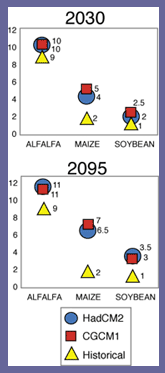|
Agriculture Agriculture is one of the most important economic activities of the Great Lakes region, accounting for more than $15 billion/year. Crop diversity is an important characteristic of agriculture in the region partially due to the moderating influence of the Great Lakes on regional climate. Models suggest that future crop yields may be greater than historical yields through 2050, and then may decrease with time from 2051-2100. Interannual variability of all projected future crop yields may tend to decrease with time, especially after 2050. Simple adaptations to a changing climate such as a switch to a longer-season variety or earlier planting date were found to result in significant increases in potential crop yield. Great Lakes Regional Summary–Agriculture (PDF) available here The figure at the right shows how the warmer and wetter climate for the Great Lakes region, suggested by model results, may lead to a northward shift of some current crop production areas. Greater agronomic potential may be possible for northern sections of the region, even with less suitable soils. The average yields for maize and soybean increase dramatically by the 2090-2099 relative to historical yields ranging from 276% for soybean to 343% for maize in the Hadley (HadCM2) Model. The increases for alfalfa were smaller at 29% for the Hadley Model. |
|
Climate Change & Fruit Production: An Exercise in Downscaling
Further assessment findings for the assessment decade of 2025-2034 lake-modified regions surrounding Lake Michigan will experience a moderate increase in growing season length and seasonal heat accumulation and a decrease in the frequency of subfreezing temperatures. In addition, important growth stages for perennials (such as commercial fruit trees) will occur earlier in the calendar year than at present. Very large changes in temperature threshold parameters are projected for the assessment decade of 2090-2099, especially for the eastern shore of Lake Michigan. It is unclear for both assessment decades whether perennials (specifically, commercial fruit trees) will be more or less susceptible to damage from cold temperatures after critical growth stages have been reached. The simulations from the HadCM2 model suggest less susceptibility, whereas the simulations from the CGCM1 model suggest greater susceptibility (Downscaling (PDF) report available here)
